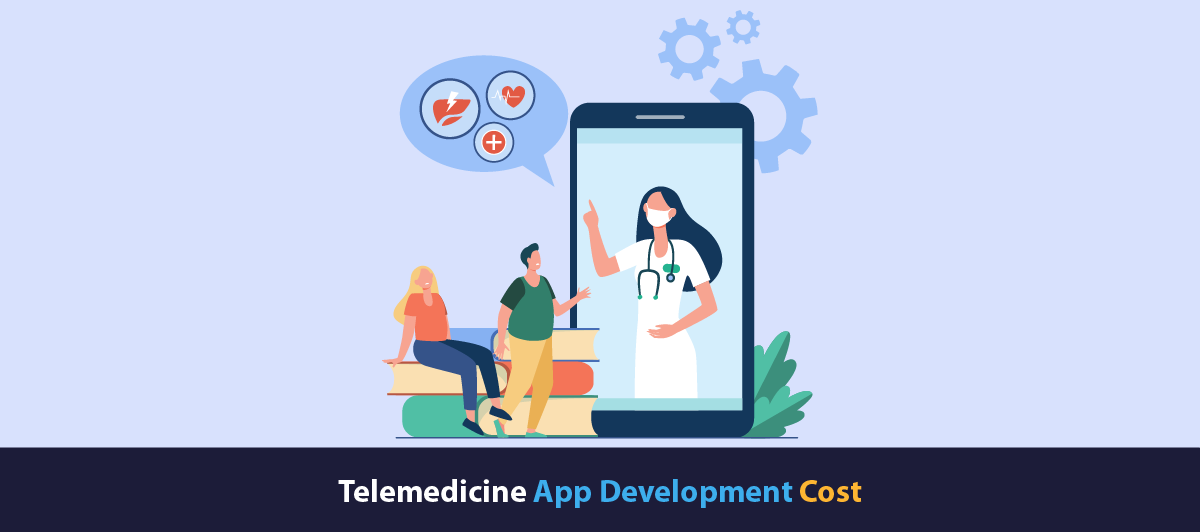What Will Be Estimate Cost Of Telemedicine App Development
Quick Summary: Explore the future of healthcare with an innovative custom tele-medicine app! Demonstrate the power of technology to make healthcare simpler and more convenient for patients around the world. Transform the way health care is delivered from virtual counseling to remote monitoring. Reap the benefits of reducing surgical costs, increasing patient satisfaction and improving access to healthcare. Embrace innovation and elevate your healthcare services with a customized telemedicine app!
Introduction
In today’s fast-paced world, the demand for telemedicine services has increased exponentially. With the ease of accessing healthcare remotely, telemedicine program have become essential tools for patients and healthcare professionals. As healthcare continues to evolve, Telemedicine App Development is necessity.
But before building telemedicine apps you need to analyze cost of developing!
The estimated cost of a telemedicine software development and app development depends on a variety of factors. These factors includes features, complexity, platform compatibility, security measures, and development team expertise. Flexible resources such as video consulting, scheduling work, electronic prescribing, secure messaging, and extensive patient data management impact costs.
While the initial investment in a telemedicine app is bit complex, it is important to consider the long-term benefits that telehealth services have. These apps streamline healthcare delivery, improve patient access to treatment, reduce administrative burdens, and improve overall healthcare.
In this article, we’ll discuss key factors that affect the cost of developing a telemedicine or mobile telehealth app or apps.
So, keep reading!
Overview To Telemedicine App Development
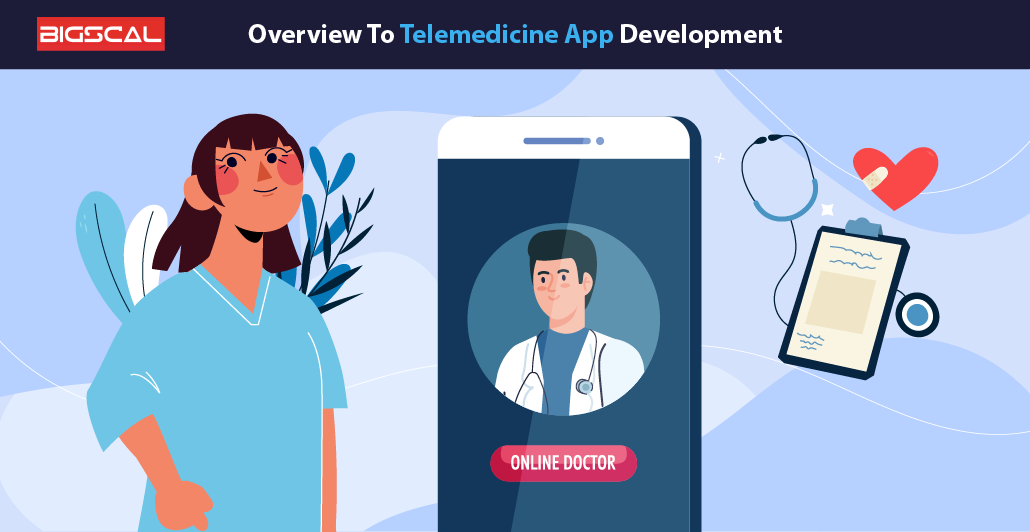
The growth of mobile telemedicine app involves the invention of a digital platform that allows medical providers to provide distant medical services to patients. The process commences by pinpointing the target audience and defining the telehealth app development’s plans, such as honest advice, meeting scheduling, and patient health which will be observed remotely
The next step is to design the user interface (UI) and user experience (UX) to ensure easy navigation and interaction for healthcare professionals and patients this includes creating soft features such as appointments will work, video conferencing for a virtual care consultation, secure messaging, electronic health record (EHR) integration to access patient information In addition
To protect patient data and ensure privacy, manufacturers must prioritize compliance with security and health regulations such as HIPAA (Health Insurance Portability and Accountability Act). This includes implementing encryption protocols, access controls, and regular security audits of medical devices.
Integration with third-party services such as payment gateways, pharmacy dispensing services, and remote medical device communications improves app performance Testing to detect and prevent errors it is important to answer any usage issues before starting the app.
Finally, marketing strategies are needed to promote the app among health-care professionals and patients, highlighting such benefits as features, availability, and cost New features and combinations help improve the app’s performance and user satisfaction over time.
Irresistible Need Of Telemedicine Software or App For Healthcare Provider?
Telemedicine solutions software or telehealth app development offers many benefits for healthcare professionals, patients, and the healthcare system as a whole. Here are some reasons and Uses of Telemedicine App Development why it is worthwhile to develop telemedicine software or an app:
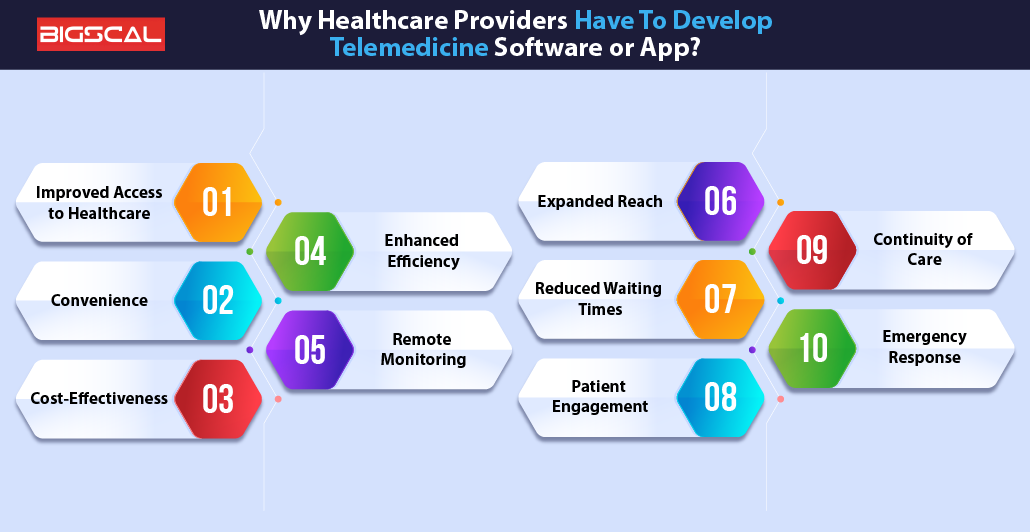
Improved Access to Healthcare
Telemedicine software or apps can play an important role in improving healthcare, especially for individuals who live in remote or underserved areas. Telemedicine software costs and enables patients to consult with healthcare providers without having to travel physically, reducing distance, travel and time barriers This increased accessibility ensures that individuals are able to access timely medical advice, diagnosis and treatment , and leads to better health outcomes and can prevent sufficient deterioration of health conditions towards shared care.
Convenience
Telemedicine apps offer unparalleled convenience to patients and healthcare professionals. Patients can schedule appointments, seek advice, and receive treatment in the comfort of their home or work. This eliminates the need for long wait times in hospital or hospital, reduces stress and increases overall patient satisfaction. For health care providers, telemedicine offers flexibility in scheduling, time management, and the ability to care for larger numbers of patients without compromising quality of care.
Cost-Effectiveness
The use of telemedicine apps can result in significant cost savings for healthcare providers and patients. By eliminating the need for in-person visits, telemedicine reduces office maintenance, personnel resources, and overhead costs, Patients save money on travel, parking, and about potential childcare or eldercare costs when they opt for a virtual check-in. In addition, telemedicine can reduce the cost of health care in terms of missed work days due to medical appointments and reduces the overall financial burden of cost on health care systems.
Enhanced Efficiency
Telemedicine technology streamlines healthcare processes, increasing productivity across the enterprise. Healthcare professionals can better manage appointments, access patient records remotely, and collaborate with colleagues through teleconferencing tools. This streamlined workflow reduces administrative burdens, improves communication between healthcare teams, and ultimately enhances quality and continuity of patient care Patients benefit from medical advice rapid access, rapid refilling of prescriptions, and seamless communication between the various health professionals involved in their treatment.
Remote Monitoring
Telemedicine apps allow patients to monitor their health status remotely, especially those with chronic diseases or receiving post-operative care. Through the integration of wearable devices, sensors and digital health tools into telemedicine platforms, healthcare professionals can remotely monitor vital signs, medication adherence and progress This real-time assessment facilitates engagement early, adapted personalized care and early use of health information to improve patient outcomes and reduce hospital readmissions It also empowers and compels you to actively participate in your service journey promoting management of chronic conditions between health visits.
Expanded Reach
As advanced technology continues evolving, healthcare providers are innovating the use of telemedicine apps to reach more people than they did before. This technology allows patients to seek health care services within no time, especially those in distant and poorly serviced locations. Through telemedicine facilities, patients and the practitioners of the health care services are able to communicate, regardless of the distance, thereby enhancing the access and outcome to health care.
Reduced Waiting Times
The cyberspace has made telemedicine attractive to patients how wait time can be reduced, by allowing the patients to go for telephonic consults. Patients do not need to waste hours waiting in a clinic or hospital but book slots online and attend virtually to get a health care provider’s attention within a reasonable time. There is thus improvement on the patient management level, and even on the schedules of the health care providers, which helps in the efficient use of resources.
Patient Engagement
Telemedicine encourages and sustains patient engagement by providing easy access to the health care providers. Patients can be able to view their files, book appointments and follow up the plans through these appointments. There is enhanced synergy of patients and health care practitioners as a result of increased interaction, which helps in better health care and more content patients.
Continuity of Care
Telemedicine software ensures continuity of care by enabling seamless communication between healthcare professionals and patients. Patients will be able to access ongoing assessments, medication management and consultation remotely, enhancing their overall healthcare experience. This continuum of care is especially useful for patients with chronic conditions that require regular treatment.
Emergency Response
Telemedicine plays an important role in emergencies by providing rapid access to medical advice and testing services. Patients will be able to receive assessments and initial consultations remotely, reducing the burden on emergency departments and improving response times to critical incidents. This timely intervention can have a significant impact on patient outcomes in emergency situations, making telemedicine an important tool for healthcare employees.
Why Is it Necessary To Analyze Telemedicine App Development Cost?
Telemedicine apps are necessary for executing the medical tasks faster, clients and healthcare professionals both take advantage of single app. Patients are free to schedule time from any location with a single click. However, doctors can accept their appointment through a digital device. This is just one example, but they can do immense activities.
Furthermore, the activities include remote monitoring, automatic reminders, billing, and an e-billing system. You can develop your app for customized options or purchase a pre-built app like Healthray. If you want to develop an app, you must scrutinize expenses on it. Analyzing the cost of developing a telemedicine app is important for several main reasons:
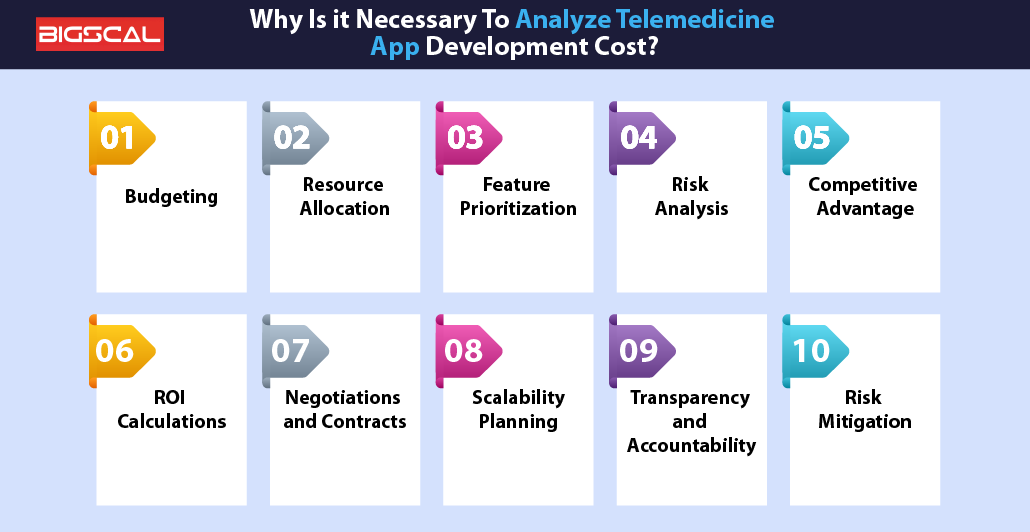
- Budgeting: Understanding costs helps create realistic budgets, and ensures that resources are allocated efficiently and effectively.
- Resource allocation: Allows for appropriate allocation of resources such as money, time, and labor, and prevents excessive or unnecessary allocation during development.
- Feature Prioritization: Cost analysis helps prioritize resources based on importance and feasibility within the given budget, ensuring that required activities are included.
- Risk Analysis: Cost analysis enables a better risk assessment by identifying potential cost overruns, delays, or limitations in development.
- Competitive Advantage: Knowing development costs helps compare to competitors, ensuring competitive pricing strategies and pricing metrics.
- ROI Calculations: Cost analysis helps calculate the return on investment (ROI) of a telemedicine app, helping stakeholders make informed decisions about the feasibility of the project.
- Negotiations and Contracts: This provides a basis for negotiations with development teams or vendors, and helps to draft contracts that accurately specify deliverables, timelines, and cost structures.
- Scalability planning: Understanding costs facilitates scalability planning, allowing future updates, developments, and maintenance of the telemedicine app without significant financial pressure
- Transparency and Accountability: Transparent cost analysis encourages accountability among stakeholders, and ensures clear communication and aligned expectations throughout the development process.
- Risk Mitigation: Understanding telehealth software development costs early can mitigate potential risks related to funding constraints early in the development cycle, reducing the likelihood of project failure or cost escalation later on.
Factors To Analyze Cost Of Telemedicine App Development
There are various factors in developing a telemedicine app that can affect the overall, telemedicine software cost and platform cost. Here are some of the major factors that can affect the Cost To Make An App:
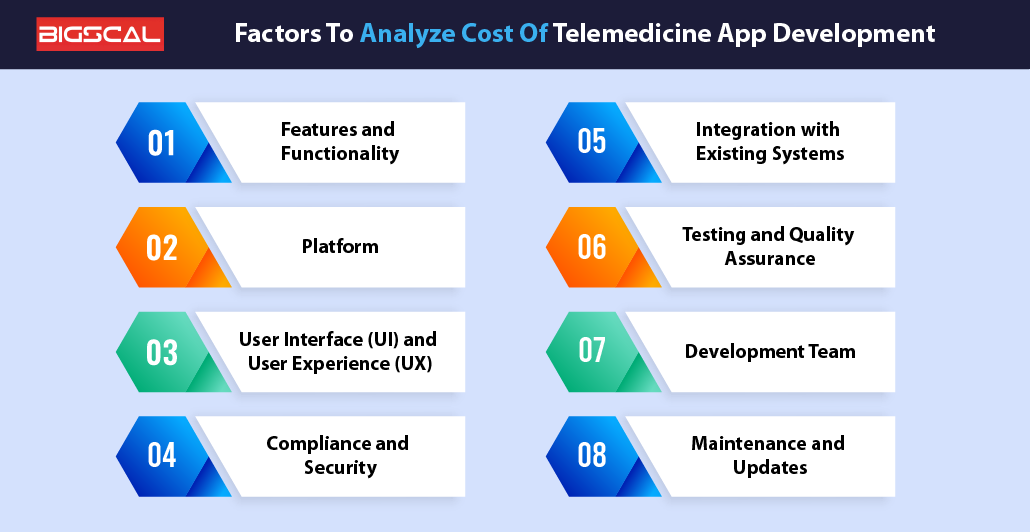
Features and Functionality
The complexity and features of your app will greatly affect its cost. Basic features such as video counseling, appointment scheduling, secure messaging, electronic prescribing, and patient record management are common. However, advanced features such as AI-powered diagnostics, integration into wearables, or remote monitoring could increase costs.
Platform
Depending on whether you want to build an app for only one platform (e.g., iOS or Android) or multiple platforms (cross-platform or native), app development costs can vary. Cross-platform may seem cheaper at first, but native will help you create better performance and user experience. Cross-platform uses the same code for different operating systems.
User Interface (UI) and User Experience (UX)
UI/UX plays a vital role in user satisfaction and engagement. The more you invest on intuitive interfaces, flexible navigation system, and responsive systems the better it is for cost of development. Like if you want flexible + motiondesigns website, cost would be higher.
Compliance and Security
Telemedicine platforms and apps need to follow healthcare regulations like HIPAA (Health Insurance Portability and Accountability Act) in the US or similar regulations in other countries. Building a strong security layer to secure patient data can mean higher development costs and longer effort to make sure of compliance.
Integration with Existing Systems
If you need the app to integrate with existing health systems such as electronic health records (EHRs), payment gateways, or third-party APIs for lab results or medications written for will combine to add complexity and cost to the development process.
Testing and Quality Assurance
Appropriate testing and quality (QA) strategies are required to ensure application performance, error-free, and seamless user experience. Budget testing and QA activities is important and can impact overall costs.
Development Team
Also, the skills and region of your telehealth app or software development team influence the price. Usually, the more experienced developers, designers, QA engineers and project managers you opt for ― the higher the cost. Moreover, developers have different rates per hour in their regions (in USA or West Europe higher than in East Europe, Asia or South America).
Maintenance and Updates
Maintenance, updates and support for healthcare services are needed once the app is live. It’s important to budget for post-launch costs so that your app remains operational, secure and compliant with evolving health standards.
The Estimate Cost Of Telemedicine App Development Based On Above Factors
The cost of a telemedicine app can be estimated based on the above factors. So, based on above factors telemedicine platform cost comes out to be as follows :-

Features
- Basic Features: A basic telemedicine app with features like video consultation, appointment scheduling, secure messaging may cost between $30,000 to $50,000
- Advanced features: If you want to have some advanced features like EHR, AI symptom checker, prescribing system etc., then the cost can vary from $50,000 to $100,000 or even more.
Platform
- Normally, creating for a single platform (iOS or Android) is cheaper than creating for both. With each added platform, the cost can be 50% to 100% more.
Design Complexity
- Complex Design: Custom designs that you don’t have to think about cost about $10-30k extra.
Regulatory Compliance
- Making sure you comply with healthcare regulations like HIPAA (Health Insurance Portability and Accountability Act) makes things more complicated and expensive. Budget between $5,000 and $20,000 for this type of work.
Development Team Location
- The development rate is dependant on the location of the development team. Compared to Eastern Europe, Asia, or Latin America, the numbers are higher in North America and Western Europe.
Testing and Maintenance
- Don’t forget to budget for testing, debugging and ongoing maintenance. This can amount to 20% to 30% of total development costs per year.
Considering these factors, the telemedicine startup costs can range from $30,000 for a basic application to $150,000 or more for a feature-rich, multi-platform application many with advanced functions and compliance mechanisms.
Approach Bigscal Technologies For Telemedicine Mobile App Development?
At Bigscal Technologies, we understand the increasing importance of accessible and efficient healthcare solutions, especially in today’s digital age. Our team of hardworking, experienced professionals are passionate about developing groundbreaking telemedicine mobile apps that change the way healthcare is delivered. When you choose Bigscal to develop your telemedicine app, you are making a choice of quality, innovation, and reliability.
We prioritize understanding your unique needs and goals. Our personalized approach ensures that your telemedicine Custom Application Development Services is tailored to meet the specific needs of your healthcare facility or organization. We use the latest technology and industry best practices to achieve a seamless user experience for healthcare professionals and patients.
Our track record speaks for itself, with many successful telemedicine app deployments that have led to better data and improved patient outcomes. We are committed to transparency, timely delivery and ongoing support to ensure the success and scalability of your telemedicine solution.
The partnership with Bigscal Technologies means unlocking the full potential of telemedicine to improve patient care.
Conclusion
The estimated cost of developing a telemedicine app can vary widely depending on a variety of factors. And you have read all factors. Investing in telemedicine app development can improve patient outcomes, increase access to healthcare services, reduce healthcare costs, and increase patient-provider communication. Not that these benefits help for delivering healthcare not only efficiently but also in line with the growing demand for remote healthcare solutions.
Thus, despite the initial investment, the long-term benefits and positive impact on healthcare accessibility and efficiency. Make telemedicine app development a worthwhile investment it is a viable and useful strategy for healthcare professionals looking to innovate and deliver better patient care.
FAQ
What is telehealth business?
The telehealth industry involves the remote delivery of medical services through telecommunications technology. This includes virtual consultation, remote monitoring and digital health solutions to improve access to healthcare and patient outcomes.
Define telemedicine equipment costs.
Telemedicine equipment costs refer to the costs of acquiring and maintaining the technology necessary for remote medical consultations such as video conferencing software, medical devices, and secure data communication systems.
How profitable is telehealth?
Telehealth can be even more profitable due to reduced costs, increased patient advocacy, and efficiencies. However, profitability varies depending on factors such as coverage, service offered and market demand.
What app is used for telehealth?
Several apps are used for telehealth, including Amwell, Doctor on Demand, Teladoc, and Zoom for Healthcare. These techniques enable remote counseling, digital health monitoring, and secure communication between patients and healthcare professionals.
What technology is needed for telehealth?
Technologies needed for telehealth include
- video conferencing software,
- Secure messaging
- Electronic health record (EHR) systems
- Remote medical devices
- Reliable Internet connectivity
